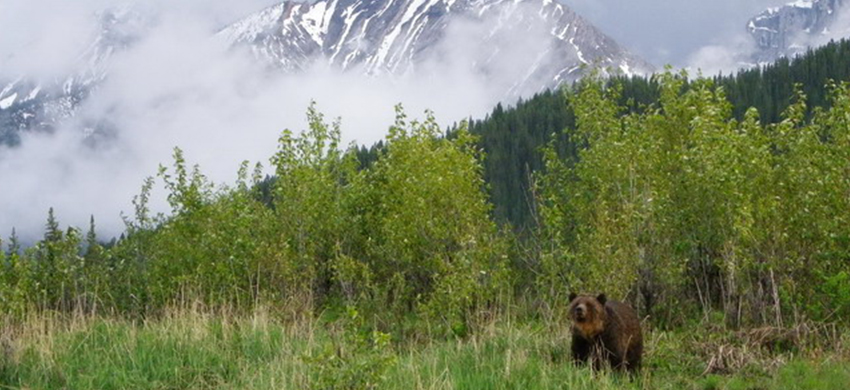
Conservation
Bears in the mountain national parks
Bears are among the most fascinating creatures on the planet: true symbols of the wild, yet almost human-like in some ways. They can be funny, smart, adaptable, powerful beyond belief . . . and yet incredibly vulnerable. If you have had the privilege of seeing a bear in the wild, you will agree—they capture our imaginations and connect us to nature. A world with no bears would be, well, unbearable.
Join the conservation team! Together, we can ensure bears will be making a living here long into the future.
Our Philosophy
When the Dominion Parks Service was established in 1911, its purpose was to preserve examples of Canada’s natural and human heritage for the benefit, education and enjoyment of Canadians. Our name and our management practices have evolved over time, but Parks Canada’s core conservation principle remains the same: to ensure that all that is embodied in our national protected places will persist, unimpaired, for future generations to enjoy.
A World Leader
Today, Parks Canada is a world leader in bear conservation. Much of our knowledge and expertise is rooted in conservation efforts undertaken in the Rocky Mountain National Parks. We have learned that protecting bears encompasses much more than basic resource management: it involves a complex “big picture” approach that considers all of the values on the land, including native biodiversity, natural processes and human use.
A Team Effort
One of the challenges for bears here is that our human presence continues to expand within and around our park borders. This ever-changing line between wilderness and development makes it harder for bears to find the space and habitat they need to make a living. The mountain parks provide a refuge in the greater landscape. Achieving healthy regional ecosystems requires help from neighbours and partners across boundaries.
We all need to consider the effects of our actions on other species. Our goal is to increase both human and bear safety and ensure bears continue to survive in the wild, as well as in our imagination. Today, we have renewed optimism that with the help of partners, park users and all Canadians, we can meet this challenge.
Action
A number of bear-related management actions that support this conservation philosophy are underway in Banff, Jasper, Kootenay and Yoho. Many of these target grizzly bear conservation, as grizzly bears are a species of Special Concern and an important indicator species in all the mountain parks.
Grizzly Bear Conservation
Grizzly bears are an enduring symbol of the wilderness of the Canadian Rocky Mountains. This wide-ranging species is broadly accepted as an indicator of the health and diversity of mountain ecosystems and as a measure of sustainable land use practices. Where grizzly bears are thriving, we can feel confident that the life requirements of many other mountain species are being met.
Our Goal
Parks Canada, along with provincial partners in British Columbia and Alberta, has established a goal of maintaining a non-declining grizzly bear population in the Rocky Mountains. Grizzly bear research across North America has led to the development of key concepts and analytical tools for managing grizzly bears. These include mortality targets and ensuring habitat security, especially in core reproductive areas. Parks Canada will apply these concepts, in conjunction with the most recent knowledge of bear habitat use and behaviour in the mountain parks, in order to ensure a sustainable, viable population of grizzly bears, and provide visitors with the opportunity for wilderness travel in a landscape also occupied by bears.
Female Grizzly Bears
The survival of reproductive females is the key factor affecting population persistence, especially in light of research findings showing that the mountain park grizzly bear population has the lowest reproductive rate documented for this species in North America. The target for human-caused mortality of independent female grizzly bears in Banff, Jasper, Yoho and Kootenay is set at no more than 1.2% of the total population, based on a four-year running average.
Habitat Security
Grizzly bear habitat is considered secure when the animals have a low probability of encountering humans and can go about their activities with little human-caused disturbance. Areas with high habitat security are also likely to be high quality environments for wilderness recreation. Managing for habitat security will help to maintain grizzly bears, while also maintaining the unique character of place that contributes to visitor experience and enjoyment.
Human Activity
Predictability of human activity helps bears avoid people. When human activity is predictable in space and time, there are fewer bear-human conflicts, fewer human injuries and fewer human-caused bear mortalities. Parks Canada will continue to use grizzly bear habitat security targets based on validated, current analytic models as a key tool to manage development and human use. To that end, the parks have been divided into landscape management units that are roughly equivalent in size to the area of a single female grizzly’s home range. Parks Canada will strive to maintain or improve calculated habitat security in each of these landscape management units.
Management Priorities
- Build public awareness and understanding of bear ecology and behaviour.
- Minimize conflict between humans and bears.
- Minimize bear mortality from unnatural causes, such as collisions with vehicles and trains.
- Maintain safe access for grizzly bears to available habitat throughout the landscape.

© Steve Michel
Related links
- Date modified :